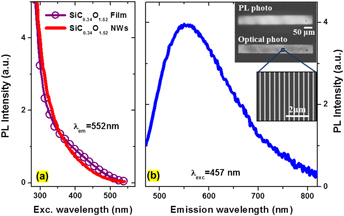Crossref Citations
This article has been cited by the following publications. This list is generated based on data provided by
Crossref.
NARISAWA, Masaki
HOKAZONO, Hiroki
MITSUHARA, Kei
INOUE, Hirofumi
and
OHTA, Toshiaki
2016.
Structure and properties of white Si–O–C(–H) ceramics derived from polycarbosilane by thermal oxidation curing and H<sub>2</sub> decarbonization process.
Journal of the Ceramic Society of Japan,
Vol. 124,
Issue. 10,
p.
1094.
Tabassum, Natasha
Nikas, Vasileios
Ford, Brian
Huang, Mengbing
Kaloyeros, Alain E.
and
Gallis, Spyros
2016.
Time-resolved analysis of the white photoluminescence from chemically synthesized SiCxOy thin films and nanowires.
Applied Physics Letters,
Vol. 109,
Issue. 4,
Kaloyeros, Alain E.
Jové, Fernando A.
Goff, Jonathan
and
Arkles, Barry
2017.
Review—Silicon Nitride and Silicon Nitride-Rich Thin Film Technologies: Trends in Deposition Techniques and Related Applications.
ECS Journal of Solid State Science and Technology,
Vol. 6,
Issue. 10,
p.
P691.
Ford, Brian
Tabassum, Natasha
Nikas, Vasileios
and
Gallis, Spyros
2017.
Strong Photoluminescence Enhancement of Silicon Oxycarbide through Defect Engineering.
Materials,
Vol. 10,
Issue. 4,
p.
446.
Tabassum, Natasha
Kotha, Mounika
Kaushik, Vidya
Ford, Brian
Dey, Sonal
Crawford, Edward
Nikas, Vasileios
and
Gallis, Spyros
2018.
On-Demand CMOS-Compatible Fabrication of Ultrathin Self-Aligned SiC Nanowire Arrays.
Nanomaterials,
Vol. 8,
Issue. 11,
p.
906.
Stabler, Christina
Ionescu, Emanuel
Graczyk‐Zajac, Magdalena
Gonzalo‐Juan, Isabel
and
Riedel, Ralf
2018.
Silicon oxycarbide glasses and glass‐ceramics: “All‐Rounder” materials for advanced structural and functional applications.
Journal of the American Ceramic Society,
Vol. 101,
Issue. 11,
p.
4817.
Hamisu, Aliyu M.
Wardana, Fendi Y.
Ariffin, Azhar
Baig, Irshad
Malliakas, Christos D.
and
Wibowo, Arief C.
2019.
A new synthetic approach for substitutional solid solutions in a 3D coordination polymer: Cation vacancy, and tunable photoluminescence.
Journal of Solid State Chemistry,
Vol. 279,
Issue. ,
p.
120948.
Tabassum, Natasha
Nikas, Vasileios
Kaloyeros, Alex E.
Kaushik, Vidya
Crawford, Edward
Huang, Mengbing
and
Gallis, Spyros
2020.
Engineered telecom emission and controlled positioning of Er3+ enabled by SiC nanophotonic structures.
Nanophotonics,
Vol. 9,
Issue. 6,
p.
1425.
Vivaldo, Israel
Ambrosio, Roberto C.
López, Roberto
Flores-Méndez, Javier
Sánchez-Gaspariano, Luis A.
Moreno, Mario
and
Candia, Filiberto
2020.
Enhanced Photoluminescence of Hydrogenated Amorphous Silicon Carbide Thin Films by Means of a Fast Thermal Annealing Process.
Materials,
Vol. 13,
Issue. 11,
p.
2643.
Niu, Jiahong
Meng, Songhe
Li, Jinping
Jin, Hua
Yi, Fajun
and
Qin, Yaoyao
2020.
Growth of multi-morphology amorphous silicon oxycarbide nanowires during the laser ablation of polymer-derived silicon carbonitride.
Ceramics International,
Vol. 46,
Issue. 2,
p.
2086.
Shyam, Sukalyan
and
Das, Debajyoti
2021.
Phosphorus-doped nanocrystalline silicon-oxycarbide thin films.
Journal of Alloys and Compounds,
Vol. 876,
Issue. ,
p.
160094.
Park, Jin-Hyeok
Kim, Chan-Hwi
Lee, Ju-Hyeon
and
Kim, Han-Ki
2021.
Transparent and Flexible SiOC Films on Colorless Polyimide Substrate for Flexible Cover Window.
Micromachines,
Vol. 12,
Issue. 3,
p.
233.
Kaloyeros, Alex E.
and
Gallis, Spyros
2022.
Polarization-dependent photoluminescence properties of fab-compatible nanowire-based nanophotonic structures.
Applied Physics Letters,
Vol. 120,
Issue. 23,
Bobrin, Valentin A.
Hackbarth, Haira G.
Yao, Yin
Bedford, Nicholas M.
Zhang, Jin
Corrigan, Nathaniel
and
Boyer, Cyrille
2023.
Customized Nanostructured Ceramics via Microphase Separation 3D Printing.
Advanced Science,
Vol. 10,
Issue. 32,
Artus, Georg Robert Johannes
Bottone, Davide
and
Seeger, Stefan
2023.
Silicon Oxycarbide Coatings Consisting of Defined Bottom–Up‐Grown Nanostructures.
Small,
Vol. 19,
Issue. 41,
Ahmed, F.
Halindintwali, S.
Arendse, C.J
Nemraoui, O.
Mtshali, C.
and
van Loosdrecht, Paul H.M.
2023.
Structural properties and optical modeling of thermally annealed silicon carbide thin films.
Materials Today: Proceedings,
Rasadujjaman, Md
Zhang, Jinming
Spassky, Dmitry A.
Naumov, Sergej
Vishnevskiy, Alexey S.
Vorotilov, Konstantin A.
Yan, Jiang
Zhang, Jing
and
Baklanov, Mikhail R.
2023.
UV-Excited Luminescence in Porous Organosilica Films with Various Organic Components.
Nanomaterials,
Vol. 13,
Issue. 8,
p.
1419.
Kaloyeros, Alain E.
and
Arkles, Barry
2023.
Silicon Carbide Thin Film Technologies: Recent Advances in Processing, Properties, and Applications - Part I Thermal and Plasma CVD.
ECS Journal of Solid State Science and Technology,
Vol. 12,
Issue. 10,
p.
103001.
Güneren, Alper
Mičušík, Matej
Precnerová, Magdaléna
and
Lenčéš, Zoltán
2024.
Insight into the slope-plateau capacity behaviour of polymer-derived silicon oxycarbide anodes in Na-ion batteries.
Journal of the European Ceramic Society,
Vol. 44,
Issue. 9,
p.
5460.
Kaloyeros, Alain E.
and
Arkles, Barry
2024.
Review—Silicon Carbide Thin Film Technologies: Recent Advances in Processing, Properties, and Applications: Part II. PVD and Alternative (Non-PVD and Non-CVD) Deposition Techniques.
ECS Journal of Solid State Science and Technology,
Vol. 13,
Issue. 4,
p.
043001.



